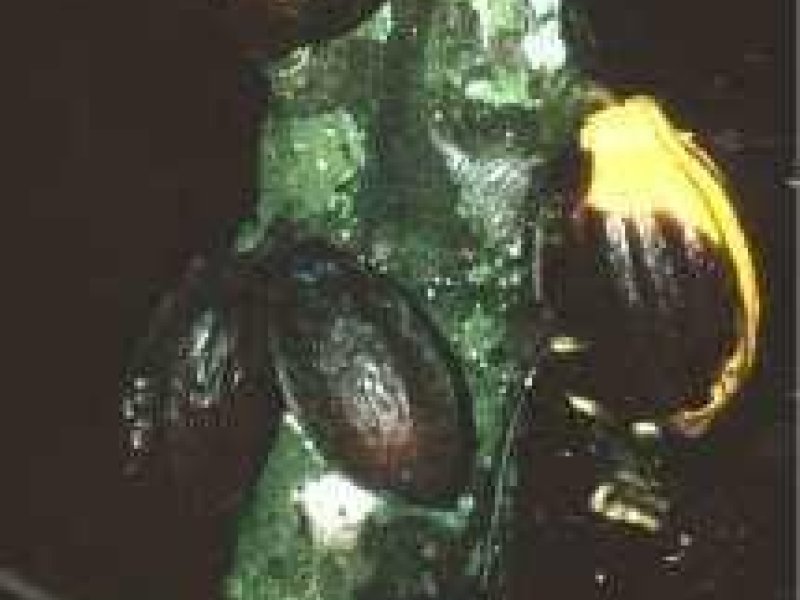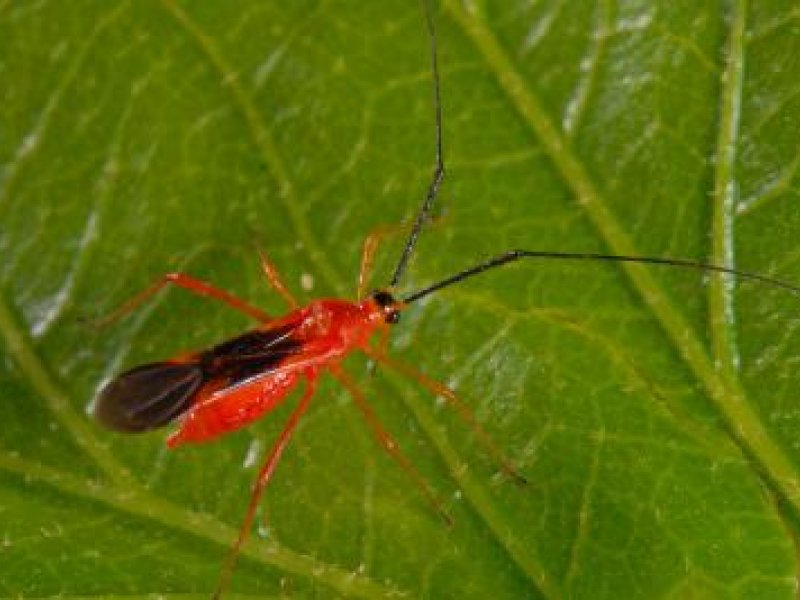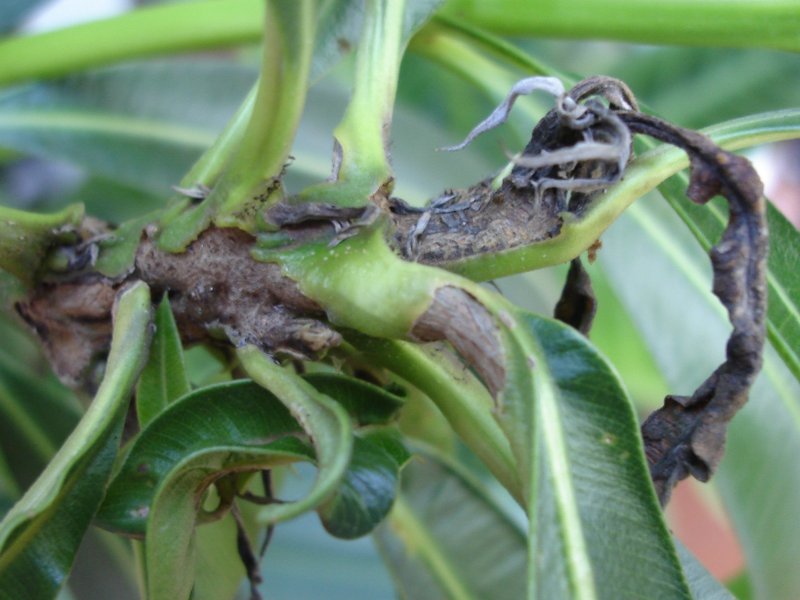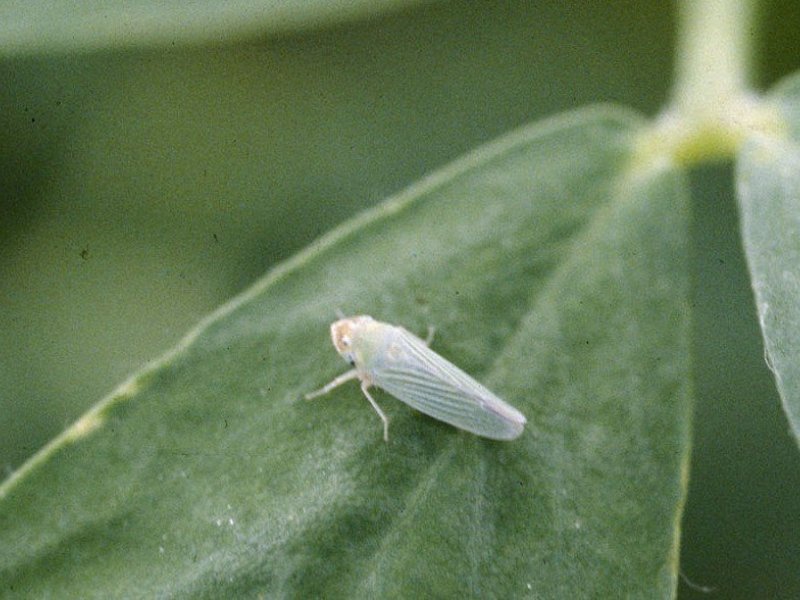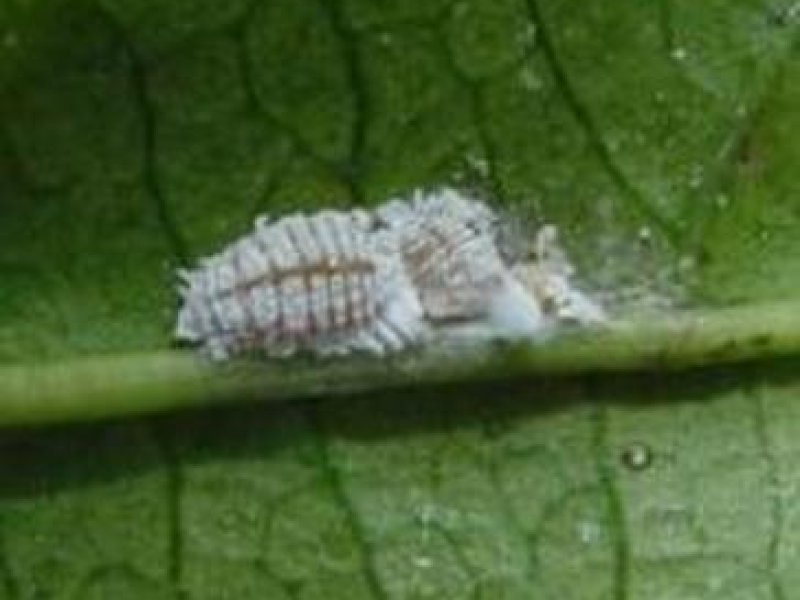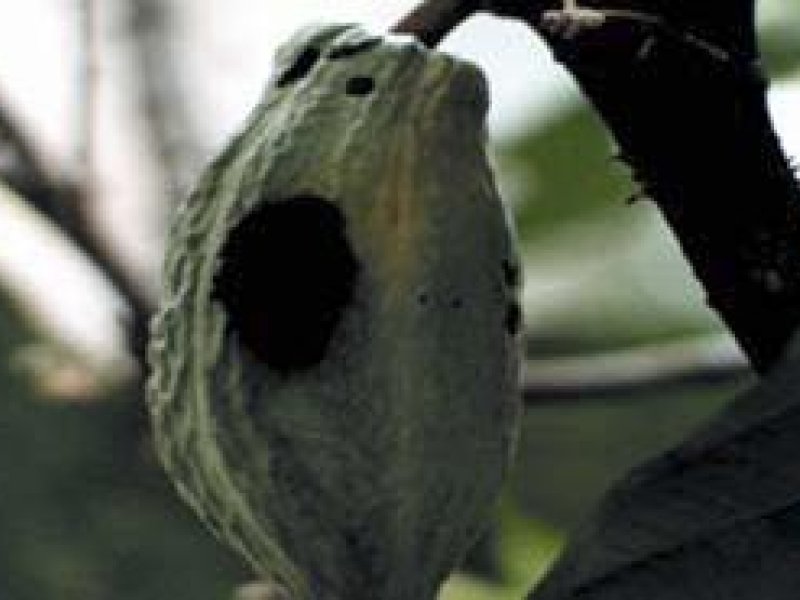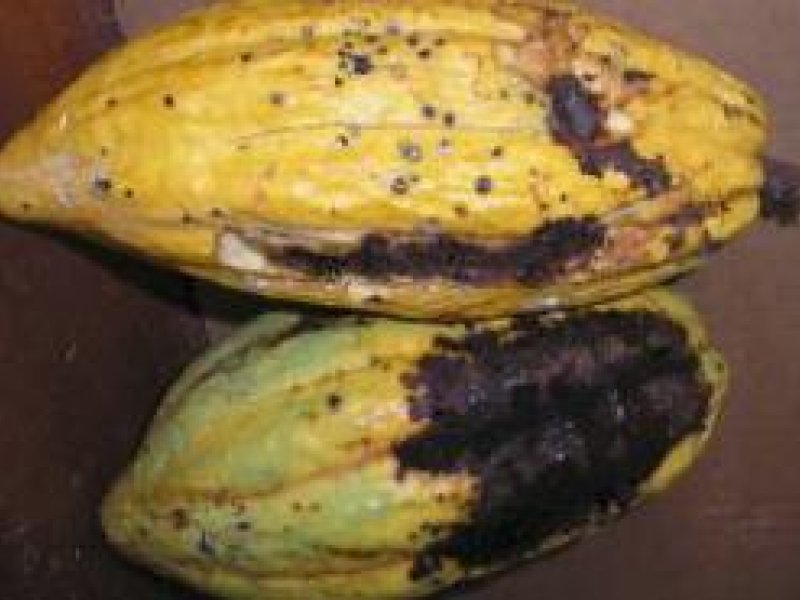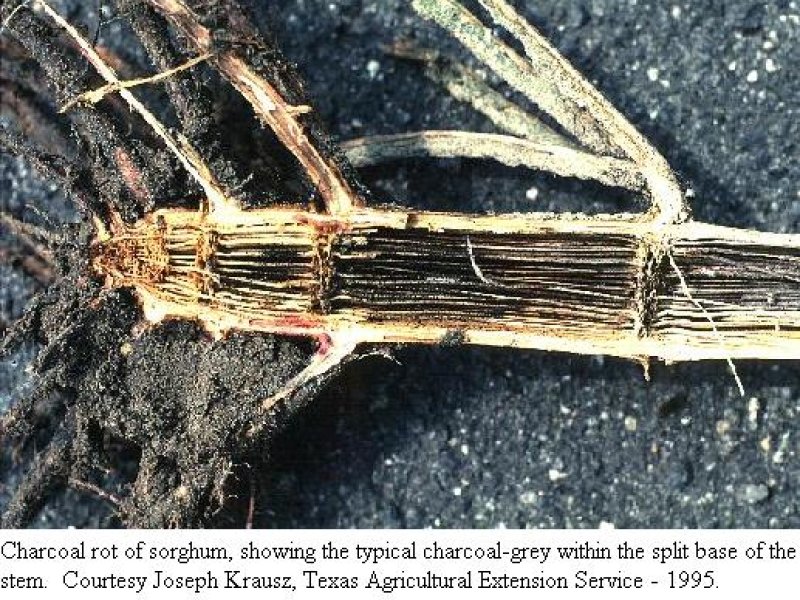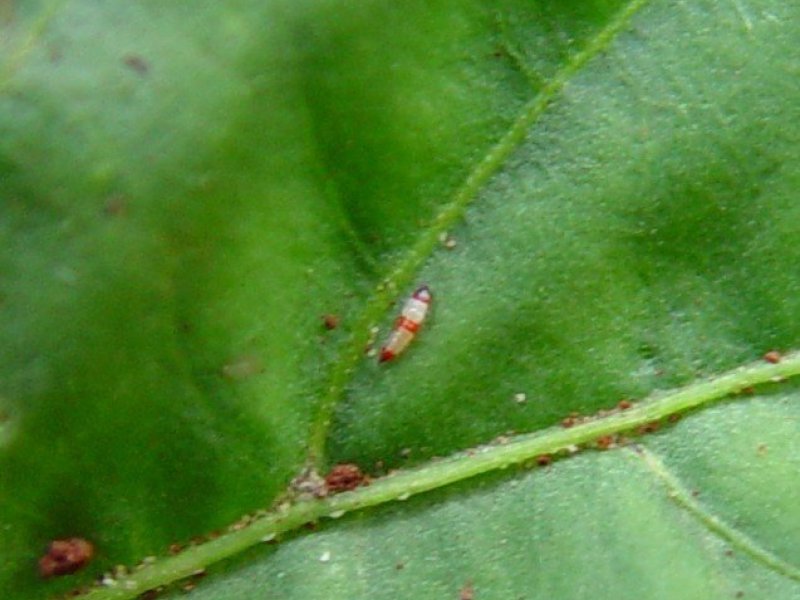|
Cocoa bud rot or Cocoa black rot (Phytophthora palmivora) It is a foot rot disease caused by the fungus (Phytophthora palmivora) which results in large pod losses in West Africa and stem canker in Trinitario populations. Cocoa bud rot attacks the whole plant. On pods, the disease begins with a circular brown lesion that enlarges to cover the whole pod. It eventually becomes black and mummified, and sometimes covered in a white mass of fungal growth (sporangia). Stem cankers are characterised by oval to round, rusty-brown discolouration of the external bark that looks purple when scraped. Attack of young shoots results in die-back. Regular harvesting plays the greatest role, as it reduces spread to other pods and bark where stem canker and flower cushion infections may develop. |
|
|
What to do:
|
|
Fruit flies Two species of fruit flies (Bactrocera dorsalis and Ceratitis capitata) attack Cocoa in Kenya. Infected fruit on the ground will act as reservoir for re-infestation. If infested fruit reaches the market then maggot infested fruit will be discarded, so allowing emerging adults access to new crop areas. When detected, it is important to gather all fallen and infected host fruits, and destroy them |
|
|
What to do:
|
|
Helopeltis bugs (Helopeltis schoutedeni) The cocoa mosquito (Helopeltis schoutedeni) also known as Helopeltis bug or mirid bugs are slender, delicate insects, about 7- 10 mm long with long legs and antennae, the antenna being nearly twice as long as the body. The females are red and the males brown to yellowish red. They lay eggs inserted into the soft tissue near the tips of flowering or vegetative shoots. Nymphs (immature bugs) are yellowish in colour. Both adults and nymphs feed on young leaves, young vegetative and flowering shoots, and developing fruits.
Typical feeding damage of Helopeltis species appears as a discoloured, necrotic (blackened) area or lesion around the affected plant tissue.
Heavy infestations by Helopeltis species can result in pod malformations and premature drop, thus providing a venue for secondary infection by microorganisms and serving to attract other pests to cacao. |
|
|
What to do:
|
|
Leafhoppers (Empoasca spp) Adult leafhoppers are small about 2 to 3 mm long and thin. The wings are held roof like over the abdomen. They are pale green to yellowish green in color, shiny and more or less transparent. The legs are slender with bristles. The nymphs resemble the adults but are smaller and do not have fully developed wings. Adults and nymphs suck sap from the leaves, remaining on the underside during the day, but also moving to the upper surface during the evening. When disturbed they run sideways rapidly to reach a shady part of the host plant.
Feeding by leafhoppers causes discoloration, and leaf curl, the outer zone of the leaf turn yellow to reddish and whither later. Heavy leafhopper infestation may retard plant growth and may cause severe yield losses. In Africa, leafhopper damage is usually minor and does not warrant control.
|
|
|
What to do:
|
|
Mealybugs Mealybugs infest fruits and foliage. They can be serious pests in the warm season, if natural enemies, which usually control them, are destroyed by spraying with pesticides.
|
|
|
What to do:
|
|
Pod-borers (Characoma stictigrapta) Pod-borers are serious pests of cocoa. The pod husk borer (Characoma stictigrapta) for example, occurs in West Africa.
The damage is done by the larva which bores holes into pods of all sizes. It produces a mass of frass held together by silk at the entrance of the holes. If the pod is very young and soft (cherelle) then it wilts. The insect is usually not controlled. |
|
|
What to do:
|
|
Pod rot of cocoa/Charcoal pod rot (Lasiodiplodia theobromae) In cocoa pod rot the infected tissue shows brown necrosis with dark brown powdery spore masses. Such infected tissues show greyish-black mycelia. The fungus is most important as a cause of postharvest food decay. It also causes damage in cocoa in the form of dieback disease. |
|
|
What to do:
|
|
Spiny bollworm (Earias biplaga) It feeds on a wide range of plants and also attacks cocoa. It may prefer wild hosts to crops. If crops are grown while wild hosts are available nearby, the crops may not be badly affected. Wild hosts will also maintain a supply of natural enemies.
The larva eats the growing tips of the stems and young soft leaves. It's feeding activity prevents the plant from growing properly to form canopy.
The attack is more where there is no shade over the cocoa. It's attack therefore may be prevented if fast growing shade trees are provided over cocoa that has been freshly planted. |
|
|
What to do:
|
|
Red-banded thrips (Selenothrips rubrocinctus) Adults of the red banded thrips are dark brown or blackish. Nymphs are pale yellow with a broad transverse red band on the dorsal side of the abdomen. Thrips attack older leaves, flowers and shoots. Attacked leaves drop off leaving bare shoots with few young leaves at the tip. Infestation of flowers causes poor fruit formation. Locally limited infestations may cause considerable damage. |
|
|
What to do:
|
Geographical Distribution in Africa
Geographical Distribution of Cocoa in Africa. Updated on 8 July 2019. Source FAOSTAT
General Information and Agronomic Aspects
Introduction
Theobroma cacao, commonly known as cocoa or cacao, belongs to the family Malvaceae. The genus Theobroma consists of 22 recognized species. However, Theobroma cacao is the most economically significant species, particularly in Africa.
The species is native to Mexico, Central America and northern South America. It is believed to have originated in the Amazon basin and was later cultivated by ancient civilizations such as the Mayans and Aztecs. Today, it is extensively cultivated in various countries around the world, including West Africa, which is the leading producer of cocoa. In its natural habitat, cocoa grows in the understorey of evergreen tropical rainforest. It often grows in clumps along river banks, where the roots may be flooded for long periods of the year. Cocoa grows at low elevations, usually below 300 metres above sea level, in areas with 1,000 to 3,000 mm rainfall per year. Cocoa is cultivated in all humid, tropical countries, in a belt between 10oN and 10oS of the Equator, where the climate is appropriate for growing cocoa trees. In Africa, the main producers of cocoa are Cote d'Ivoire (the world's largest cocoa producer), followed by Ghana, Nigeria and Cameroon.
Utilization of Theobroma cacao is primarily focused on its seeds, which are used to produce cocoa beans. These beans serve as the fundamental ingredient for the production of chocolate. The process involves fermenting and drying the beans, followed by roasting and grinding to obtain cocoa solids and cocoa butter. These components are then used in various chocolate products, confectionery items, and beverages. Butterfat is also used in cosmetics and pharmaceutical products but the amount used for these purposes is insignificant in relation to that used in chocolate manufacture.
Cocoa seeds are highly rich in fat content, and therefore provide an energy-rich and delicious foodstuff.
On the international market, raw cocoa (dried cocoa seeds) is the most sought product, which is used for production of cocoa butter, chocolate, and cocoa powder (Kew Science1, De Souza et al., 2018 2, Orwa et al., 2019)
Cocoa seeds are highly rich in fat content, and therefore provide an energy-rich and delicious foodstuff. Cocoa is cultivated in all humid, tropical countries, in a belt between 10ºN and 10ºS of the Equator, where the climate is appropriate for growing cocoa trees. In Africa, the main producers of cocoa are Côte d'Ivoire (the world’s largest cocoa producer), followed by Ghana, Nigeria and Cameroon.
On the international market, raw cocoa (dried cocoa seeds) is the most sought product, which is used for production of cocoa butter, chocolate, and cocoa powder.
Species account
Cocoa is a spindly, evergreen tree that grows to a height of 5 to 8 m. Leaves: dark green leaves are shiny, leathery, egg-shaped or elliptic in shape and 20 to 35 cm long and 7 to 8 cm wide. The leaf surfaces are hairless or covered in scattered star-shaped hairs. The base of the leaf is rounded or heart-shaped, and the tip is long and drawn out allowing water to drip from it.
Flowers: Cocoa flowers are small, yellowish white to pale pink, and grouped together in clusters arising directly from the trunk (cauliflory). Flowers are produced throughout the year. In the wild the flowers are pollinated by tiny midges, and develop into elongated fruits known as pods. Fruit: are large, ranging from 15 to 30 centimeters (6 to 12 inches) in length, and have a football-shaped or elongated form. The color of the pods can vary, with shades of yellow, orange, red, or purple. When ripe, the pods contain a sweet, mucilaginous pulp that surrounds the seeds.
There are different cultivars and genetic varieties of cocoa, each exhibiting distinct traits such as pod shape, size, color, and flavor profiles. These variations are a result of selective breeding, natural mutations, and adaptations to different growing conditions.
(Kew Science1, Orwa et al., 2019)
Main varieties grown are:
Criollo
When Criollo pods are ripe, they are long, yellow or red, with deep furrows and big warts. This variety does not produce as much as the others varieties but the cocoa is of very good quality.
Forastero (Amelonado)
In this variety, the pods are short, yellow, smooth without warts, with shallow furrows. This variety produces well, but the cocoa is of less quality than Criollo. It is the commonest variety in West Africa.
Trinitario
This variety is a cross between Criollo and Forastero. The pods are long or short, red and yellow. It yields cocoa of fairly good quality.
Ecological conditions
Cocoa grows in the primary forests in the so-called under-storey and is associated with a variety of palm species, as well as a number of other different tree varieties. For example, with tree varieties stemming from the upper storey in rain forests, among them mainly single trees overtopping the forest canopy which lose their foliage during the months of shorter daylight hours. The resulting increase in light encourages the development of the cocoa blossoms, and the falling leaves an enrichment of organic material.
With an even annual distribution of rainfall (100 mm per month), the plantations can survive on 1250 mm per year. Short drought periods can be compensated for by heavy clouds and high humidity. The average annual temperature should be around 25degC. In regions with extensive wet periods or large seasonal temperature fluctuations, the harvesting periods are reduced to only a few months per year. In regions with a balanced climate, and only slight temperature and rainfall fluctuations, cocoa produces fruit practically throughout the year. Cocoa is thus a typical crop of the tropical lowlands. It can also be grown at higher altitudes if other conditions are favorable. Especially in areas without a dry season, cocoa has shown to develop more quickly than in the major production areas of West Africa, where growth is stopped by drought during certain months of the year.
The soil on cocoa plantations should be deep, well-drained, and have sufficient water-retaining capacity. Soils with a high available moisture-storage capacity can compensate for periodic lack of rain, while excessive rainfall will cause fewer problems on well-drained soils. The pH-value should lie between 4.0 and 7.5. Care must be taken that sufficient organic material is available. Cocoa trees can live for over 100 years. Naturally occurring cocoa crops propagate themselves through lateral shoots, which can occur at any height on the trunk. The natural vegetative proliferation occurs when the seeds are spread by small rodents and apes.
Agronomic aspects
Propagation and planting
When choosing the site for a new plantation, the natural site requirements of cocoa should be adhered to. Ideal sites are those with alluvial soils, which are not susceptible to water-logging. Other suitable sites include irrigated form wells, and in hollows. Unsuitable sites are steep and convex slopes. When you create a new plantation, take care to reproduce as closely as possible the natural structure of forests. This means that all of the varieties that are to be cultivated along with cocoa in the agro eco-system should be planted at the same time (or even beforehand) as the cocoa. The best method is to leave an area free for natural growth, and to plant tall-growing trees which will rapidly provide cover, such as bananas and manioc, and to plant the cocoa in-between them at a later date. This way, the biological activity of the soil is maintained, and the mycorrhiza of the cocoa can begin to develop immediately.
Cocoa is usually planted as seedlings, which are easy and cheap to produce. Vegetative propagation by rooted cuttings or budding is used to establish seed gardens. Seedlings are usually raised in polythene bags in a shaded nursery. Young plants are planted in the field 3 - 4 m apart or about 1100 trees/ha at an age of 4 - 6 months. Young trees need shade to reduce irradiance, to buffer the microenvironment and to promote the right shape and habit of the trees. When a closed canopy has been formed, the need for shade is reduced. Only under most favorable conditions of soil and nutrient supply can cocoa be grown without shade. It is normally necessary to retain some shade to reduce moisture stress and incidence of insect damage in order to prolong the economic life of plantations.
Shade can be provided either by thinning forest or by planting shade trees. Shade trees are common in South-East Asia, where mainly seedless Leucaena leucocephala and Gliricidia sepium are used. Often, hedges of leguminous shrubs are used for temporary side-protection between rows and as a source of mulch. Cocoa is also grown as an intercrop under coconuts.
 |
| Budding of cocoa plants |
| © Putter CA (Courtesy of EcoPort, www.ecoport.org) |
Budding of cocoa plants. (©) Putter CA (Courtesy of EcoPort, www.ecoport.org).
Organic fertilization strategies
It is not advisable to use fertilizer that has not originated from the site's production, also of organic origin, because the costs are simply too high. Creating organic material through mulching and pruning activities is sufficient for an economically viable production, provided a stratified (multi-phase), diverse and densely planted system is in place. Any shells that are left over after the harvest must remain on the plantation. This means that the fruits should be broken open on site, if possible. The resulting shell material should be spread as evenly as possible. The cocoa pods harvested on a plot are first piled into a heap, and then broken open to provide around 50 kg of fresh cocoa. The cocoa pods should then be piled onto a different heap during the next harvest stage, and broken open there.
Many varieties of palms are capable of actively breaking down phosphorus, as well as binding heavy metals in the soil, which thereby reduces the amounts absorbed by the cocoa plants. This can be useful, because the amount of heavy metals in the cocoa seeds can be problematic. It is therefore recommended to integrate suitable palm varieties into the plantation.
Husbandry
During the first 3 years, selective weeding is required, whereby grasses are removed, and flowering weeds cut down to be used as mulching material. Trees which do not loose their leaves need to be radically trimmed during the blossoming period of the cocoa (about 6 months before the main harvest begins), in order to increase the amount of light. The resulting organic material should then be chopped and spread out over the soil. Diseased plant parts and pods should be removed. The cocoa trees should also be lightly trimmed, and diseased or poorly developed trees removed (in cases of direct sowing), during these shading regulation tasks.
Once the canopy has closed, lack of light will prevent weed growth. Young trees need no pruning during the first 2 - 3 years. Later, low-hanging branches should be pruned to facilitate harvesting. Vertical growth is usually restricted to the first jorquette (fan of branches). If the first jorquette is formed too low (below a height of 1.5 m), the tree is allowed to make a second one. To retain trees at the desired height, cocoa seedlings (chupons) should be removed at regular intervals.
Diversification strategies for cocoa
Cocoa can be grown with other crops but these should be varied as the cocoa plants grow. When still young, most annual and biannual crops may be grown with cocoa plants. Perennual crop plants should be faced out by about year 8 leaving cocoa as a forest understory.
Diversification strategies for Cocoa 1
 |
| © Naturland e.V. www.naturland.de/en/) |
 |
| © Naturland e.V. (www.naturland.de) |
 |
| © Naturland e.V. (www.naturland.de/en) |
 |
| © Naturland e.V. (www.naturland.de/en/) |
Rice as well as maize can be sown as a pioneer crop, depending on the starting conditions (soil fertility, market access, consumer habits, etc.), simultaneously with manioc (Manihot esculentum), new coco-jam (Xanthosoma sagittifolium) in Nigeria and Cameroon and pigeon peas (Cajanus cajan).
Before a pioneer crop is sown, bananas should be planted. The distance between each plant depends on the distances between the individual cocoa plants and the variety of banana. Along with standard commercial varieties of banana from the Cavendish group, other tall-growing local varieties which can tolerate shade should also be integrated into the plantation. The number of cocoa trees should lie between 600 and 1100 trees per ha.
During the first few years, on fertile soils, papaya (Carica papaya) can also be cultivated in addition to bananas within the system (2 x 2 m). Together with the papaya seeds or bananas, trees growing up to the middle storey (such as Inga ssp., Erytrina ssp.,Gliricida sepium) as well as growing up to the upper storey must also be planted. This can be in seed form. Only in the cases of certain varieties (such as palm varieties that are old, or difficult to germinate), should the trees be first sown in a tree nursery. The choice of tree depends on which varieties are available in the region. In addition to the varieties listed above, it is recommended to integrate palm species at a density of 100-150 trees per ha in organic cultivation systems.
Many combinations are possible, in which other fruit trees such as avocado, jackfruit and many more can be integrated. Monoculture plantations that already exist, and which have only very few shading trees can be improved. The best method is to re-forest wrongly cultivated spots, and also spaces that become available after unproductive single plants have been removed.
Harvest, post-harvest practices and markets
Harvesting
The most essential quality characteristics of cocoa depend on the correct processing, which begins with the harvesting process and ends with the storage method. Pod development from setting to maturity takes about 6 months. The harvest can begin when the pods are completely ripe. In many Trinitario types, with their red and dark violet pods, this can be recognized by an orange discolouring of the shell. Yet other varieties take on a yellow coloration when ripe. Depending on the region and weather conditions, there are usually 1 or 2 harvesting phases, which are spread out over several months. In order to achieve a uniform ripeness of the pods harvested, it is wise to harvest all of the ripened pods every 2-3 weeks. During peak production, pods are harvested each week. The best way to avoid harming the bark is to cut off the pods at the base of the blossom with a sharp knife or other suitable instrument.
Post-harvest practices.
Storage
Cocoa can be stored for years in temperate climates without fear. In the moist tropics on the other hand, the high temperatures and humidity cause a rapid infestation by storage pests and infection with mould fungi. Because cocoa is strongly hygroscopic, even a product that has been well dried can rise in moisture content up to 10% in regions with 80-90% humidity, and thereby lose its capacity to be stored. The critical moisture content for storage is 8%.
The cocoa should be stored in air-permeable sacks on the production site for only a short time, whereby the sacks should be stacked on wooden planks or boards. The use of sacks made of organic material (jute) should be avoided, if these have been treated with pesticides. The cocoa butter part in the cocoa shell is an excellent solvent for chlorinated hydrocarbons which can diffuse through the outer shell when they come into contact with it, and into the cocoa seed. In such cases, tests have then shown limits for certain agricultural poisons being exceeded - although no pesticides had ever been used on the site.
The storage area should always be well-ventilated - the inside temperature should remain below the outside temperature.
On conventional plantations, it is quite usual to gas the cocoa with methyl bromide in order to protect them against storage pests. However, it is now not allowed to use methyl bromide. In addition, tetraline soap, hydrogen phosphide and prussic acid are also used. On organic cocoa plantations, it is not permitted to use either insecticides against storage pests, or to gas the beans. Cocoa beans should be stored in dark, dry and well-ventilated rooms at low temperatures. Short-term storage: about 16degC; relative humidity: 55% Long-term storage: about 11degC; relative humidity: 55
Nutritional value
Cacao is regarded as a super food due to its high nutrient content and proven health benefits. Cocoa powder is made by crushing brown cocoa beans also called cacao and removing the fat or cocoa butter1.Cocoa is famous for its role in chocolate production. It can be consumed as a dark chocolate snack, can be taken either cold or hot as a beverage or as chocolate milk shake, as smoothies, puddings, as a vegan chocolate mousse. Cacao is a powerhouse of antioxidants, particularly flavonoids. These compounds shield have been shown to help protect the body from oxidative stress and reduce inflammation, improve blood flow, and lower blood pressure, which in turn may promote cardiovascular health2. Processing and heating cocoa can diminish its beneficial properties. Cocoa is commonly alkaline-treated to reduce bitterness, resulting in a significant 60% reduction in flavanol content1,2.
Cocoa is also a good source of minerals, including magnesium, iron, copper, and manganese. Magnesium plays a crucial role in muscle and nerve function, as well as maintaining a healthy immune system. Iron is essential for oxygen transport within the body and preventing iron-deficiency anemia. Copper and manganese are important for overall metabolic function and support the body's antioxidant defenses.
Furthermore, cocoa contains several vitamins, such as vitamin A, vitamin E, and B vitamins. Vitamin A is vital for healthy vision, immune function, and cell growth. Vitamin E acts as an antioxidant and helps protect cells from damage caused by free radicals. B vitamins are involved in energy metabolism and the proper functioning of the nervous system.
Consuming cocoa and its products in moderation can have additional benefits. Dark chocolate, which has a higher cocoa content, is particularly noteworthy for its potential mood-boosting effects. It stimulates the production of endorphins, the "feel-good" hormones, and contains compounds that promote the release of serotonin, a neurotransmitter associated with happiness and well-being.
Moreover, cocoa products can be a source of dietary fiber, which aids in digestion and helps maintain bowel regularity. They also provide a pleasurable sensory experience, potentially reducing stress and enhancing mood.
Cocoa and cocoa products have been associated with numerous health benefits like;
• Reducing inflammation
• Lowering blood pressure by improving Nitric Oxide levels due to its high flavanol content 2
• Improved cholesterol and blood sugar levels
• May lower the risk of heart attack and stroke1.
• Its polyphenols may improve blood flow to your brain and enhance brain functioning
• The flavonoids may improve mood and depression symptoms by converting tryptophan to the natural mood stabilizer serotonin
• The magnesium content in cocoa can help with maintaining healthy muscle and nervous system functioning
• Consumption of cocoa may aid in weight control and regulating the use of energy, reducing appetite, and increasing fat oxidation and feeling of fullness due to its fiber content
• The flavonoids in cocoa can slow down carbohydrate digestion and absorption in the gut, and improves the symptoms of type 2 diabetes
• Consumption of cocoa inhibits the complex molecular process leading to cancer
• Its flavanols are associated with good memory and cognitive ability.
Source (healthline.com 1, PubMed Central2, Shahanas, E et al.,20193).
Nutritive Value per 100 g of edible Portion
Raw or Cooked Cocoa |
Cocoa Powder unsweetened |
Energy (Calories / %Daily Value*) |
228 / 11% |
Carbohydrates (g / %DV) |
57.9 / 19% |
Fat (g / %DV) |
13.7 / 21% |
Protein (g / %DV) |
19.6 / 39% |
Calcium (g / %DV) |
128 / 13% |
Phosphorus (mg / %DV) |
734 / 73% |
Iron (mg / %DV) |
13.9 / 77% |
Potassium (mg / %DV) |
1524 / 44% |
Vitamin A (I.U) |
0.0 IU / 0% |
Vitamin C (I.U) |
0.0 / 0% |
Vitamin B 6 (I.U) |
0.1 / 6% |
Vitamin B 12 (I.U) |
0.0 / 0% |
Thiamine (mg / %DV) |
0.1 / 6% |
Riboflavin (mg / %DV) |
0.2 / 14% |
Ash (g / %DV) |
5.8 |
*Percent Daily Values (DV) are based on a 2000 calorie diet. Daily values may be higher or lower, depending on one’s calorie needs.
Information on Pests
Biological methods of plant protection
Organic pest and disease management places priority on indirect control methods. Direct control methods are applied as a second priority.
A variety of insect pests are important during establishment, because they destroy the apical bud and delay or prevent canopy formation. In mature cocoa, mirids (Helopeltis and other regionally specific genera) are the major widely represented insect pests, causing severe damage to twigs, branches and young pods.
An infestation by pests in a cocoa plantation has the same causes as diseases which affect a system. The causes are listed under 'diseases'.The losses caused by these pests world-wide is enormous. They result from the cocoa fruits being sucked dry in all stages of growth, after which, the plant dies off, depending to the amount of damage done.
Without losing sight of the need to combat the root causes, a solution which can be immediately utilised to save a harvest is by spraying with a 3% alkaline soap solution (potassium soap), which has proven itself in Bolivia in regulating different bug varieties. In addition, other preparations being permitted on organic farms can also be used.
Some common pests of cocoa are:
- Mealybugs (Planococcus, Stictococcus in Africa)
- Bollworms and various other psyllids
- Leafhoppers
- Thrips (Selenothrips rubrocinctus, Heliothrips rubrocinctus)
- Leaf cutter ants (Atta ssp.)
Examples of Cocoa Pests and Organic Control Methods
| Helopeltis bugs (Helopeltis schoutedeni) The cocoa mosquito (Helopeltis schoutedeni) also known as Helopeltis bug or mirid bugs are slender, delicate insects, about 7- 10 mm long with long legs and antennae, the antenna being nearly twice as long as the body. The females are red and the males brown to yellowish red. They lay eggs inserted into the soft tissue near the tips of flowering or vegetative shoots. Nymphs (immature bugs) are yellowish in colour. Both adults and nymphs feed on young leaves, young vegetative and flowering shoots, and developing fruits.
Typical feeding damage of Helopeltis species appears as a discoloured, necrotic (blackened) area or lesion around the affected plant tissue.
Heavy infestations by Helopeltis species can result in pod malformations and premature drop, thus providing a venue for secondary infection by microorganisms and serving to attract other pests to cacao. What to do:
|
| Pod-borers (Characoma stictigrapta) Pod-borers are serious pests of cocoa. The pod husk borer (Characoma stictigrapta) for example, occurs in West Africa.
The damage is done by the larva which bores holes into pods of all sizes. It produces a mass of frass held together by silk at the entrance of the holes. If the pod is very young and soft (cherelle) then it wilts. The insect is usually not controlled. What to do:
|
| Spiny bollworm (Earias biplaga) It feeds on a wide range of plants and also attacks cocoa. It may prefer wild hosts to crops. If crops are grown while wild hosts are available nearby, the crops may not be badly affected. Wild hosts will also maintain a supply of natural enemies.
The larva eats the growing tips of the stems and young soft leaves. It's feeding activity prevents the plant from growing properly to form canopy.
The attack is more where there is no shade over the cocoa. It's attack therefore may be prevented if fast growing shade trees are provided over cocoa that has been freshly planted. What to do:
|
| Mealybugs infest fruits and foliage. They can be serious pests in the warm season, if natural enemies, which usually control them, are destroyed by spraying with pesticides.
What to do:
|
| Adult leafhoppers are small about 2 to 3 mm long and thin. The wings are held roof like over the abdomen. They are pale green to yellowish green in color, shiny and more or less transparent. The legs are slender with bristles. The nymphs resemble the adults but are smaller and do not have fully developed wings. Adults and nymphs suck sap from the leaves, remaining on the underside during the day, but also moving to the upper surface during the evening. When disturbed they run sideways rapidly to reach a shady part of the host plant.
Feeding by leafhoppers causes discoloration, and leaf curl, the outer zone of the leaf turn yellow to reddish and whither later. Heavy leafhopper infestation may retard plant growth and may cause severe yield losses. In Africa, leafhopper damage is usually minor and does not warrant control.
What to do:
|
| Red-banded thrips (Selenothrips rubrocinctus) Adults of the red banded thrips are dark brown or blackish. Nymphs are pale yellow with a broad transverse red band on the dorsal side of the abdomen. Thrips attack older leaves, flowers and shoots. Attacked leaves drop off leaving bare shoots with few young leaves at the tip. Infestation of flowers causes poor fruit formation. Locally limited infestations may cause considerable damage. What to do:
|
| Two species of fruit flies (Bactrocera dorsalis and Ceratitis capitata) attack Cocoa in Kenya. Infected fruit on the ground will act as reservoir for re-infestation. If infested fruit reaches the market then maggot infested fruit will be discarded, so allowing emerging adults access to new crop areas. When detected, it is important to gather all fallen and infected host fruits, and destroy them What to do:
|
-
Information on Diseases
Biological methods of plant protection
Most diseases are caused by the following:
- Cultivation in monocropping systems with no or only very few varieties and number of shading trees (on conventional plantations, 25-40 trees of mostly one variety per ha recommended)
- Ignoring the natural rotation of the forest system. For example, cocoa plantations which grow beneath old shading trees from the secondary forest system (mostly Inga ssp., Gliricidia sepium etc.), are highly susceptible to diseases and pests. Cocoa, as a plant from the primary forest, can tolerate old primary forest trees above it, yet not trees from the secondary forest system.
- Too little distance between the different varieties in a system which have the same status; failure to thin out the agroforestry system
- Degraded and poor soils, lack of organic material
- Unsuitable site (water-logging, too dry, no possibility for deep root development)
Effective measures are often only possible in the form of improvements to the whole system. One possibility lies in radically cutting back the trees and subsequently replacing them with the correct varieties, or, with a complete renewal measure, whereby the trees are sawn down to a stump of around 40 cm. One to 3 of the resulting shoots which develop out of the stumps are left to develop. Opening up the plantation allows many new varieties to be included.
A tolerable loss at harvest time, which is also heavily dependant on weather conditions, is often caused by the fungus (Phytophtora palmivora). In addition to the measures described here, regular harvesting, which should then include diseased fruit, can reduce the infestation (many farmers only harvest the healthy fruits). In the case of a heavy infestation by Phytophtora palmivora, harvest losses can be alleviated with Bordeaux mixture, or other spray preparations containing copper, that are permitted on organic plantations. These methods should only be used in emergencies.
Examples of Cocoa Diseases and Organic Control Methods
Fungal diseases are of major importance both to the trees and the pods, although cocoa types show a wide range of susceptibility.
Fungal infections are caused by Botryodiplodia theobromae, Colletotrichum sp. (anthracnose) and Trachysphaera fructigena. On cocoa, infection with T. fructigena is an insignificant component of pod diseases.
| Cocoa bud rot or Cocoa black rot (Phytophthora palmivora) It is a foot rot disease caused by the fungus (Phytophthora palmivora) which results in large pod losses in West Africa and stem canker in Trinitario populations. Cocoa bud rot attacks the whole plant. On pods, the disease begins with a circular brown lesion that enlarges to cover the whole pod. It eventually becomes black and mummified, and sometimes covered in a white mass of fungal growth (sporangia). Stem cankers are characterised by oval to round, rusty-brown discolouration of the external bark that looks purple when scraped. Attack of young shoots results in die-back. Regular harvesting plays the greatest role, as it reduces spread to other pods and bark where stem canker and flower cushion infections may develop. What to do:
|
| Pod rot of cocoa/Charcoal pod rot (Lasiodiplodia theobromae) In cocoa pod rot the infected tissue shows brown necrosis with dark brown powdery spore masses. Such infected tissues show greyish-black mycelia. The fungus is most important as a cause of postharvest food decay. It also causes damage in cocoa in the form of dieback disease. What to do:
|
Contact information
- Gardenscape Landscaping Kenya. Cocoa beans supplier from Nairobi, Muthaiga, Kenya
- Quality Fresh Cocoa Beans. Supplier from Nairobi, Wetlands, Kenya.
- Bricksworth Ventures Limited. Cocoa bean supplier from Nairobi, Kenya
- Africa Business Consulto. Cocoa beans supplier from Kenya,
References and information links
References
1. CAB International (2005). Crop Protection Compendium, 2005 edition. Wallingford, UK www.cabi.org
2. Theobroma cacao L. | Plants of the World Online | Kew Science. (782, January 1). Theobroma Cacao L. | Plants of the World Online | Kew Science. http://powo.science.kew.org/taxon/urn:lsid:ipni.org:names:320783-2
3. De Souza, P. A., Moreira, L. F., Sarmento, D. H., & da Costa, F. B. (2018). Cacao—Theobroma cacao. In Exotic fruits (pp. 69-76). Academic Press.
4. Orwa C, Mutua A, Kindt R, Jamnadass R, Simons A. 2009. Agroforestree Database: a tree reference and selection guide version 4.0. World Agroforestry Centre, Kenya. https://www.worldagroforestry.org/output/agroforestree-database accessed on 12-07-2023.
5. S., & Team, S. (2023, April 30). All About Cacao Powder - Cacao vs Cocoa | Benefits of Cacao Powder - Satvic Lifestyle. Satvic Lifestyle. https://satviclifestyle.in/all-about-cacao-powder/
6. Shahanas, E., Panjikkaran, S. T., Aneena E.R., Sharon, C. L., & Remya, P. R. (2019). Health Benefits of Bioactive Compounds from Cocoa (Theobroma cacao). Agri Revs, 40(2):143-149.
Information links
CAB International (2005). Crop Protection Compendium, 2005 edition. Wallingford, UK www.cabi.orgHow to grow organic cocoa, illustrated Handbook, Naturland (2012). Available also online www.naturland.de
Organic Farming in the Tropics and Subtropics: Cocoa, Naturland e.V. (2000). Available also online www.naturland.de
Nutrition Data www.nutritiondata.com.
http://www.fao.org/docrep/006/AD220E/AD220E01.htm
http://www.icco.org/about-cocoa/growing-cocoa.html
http://www.technoserve.org/files/downloads/case-study-building-a-sustainable-and-competitive-cocoa-value-chain-in-peru.pdf
Review Process
Dr. Patrick Maundu, James Kioko, Charei Munene and Monique Hunziker, June 2024

